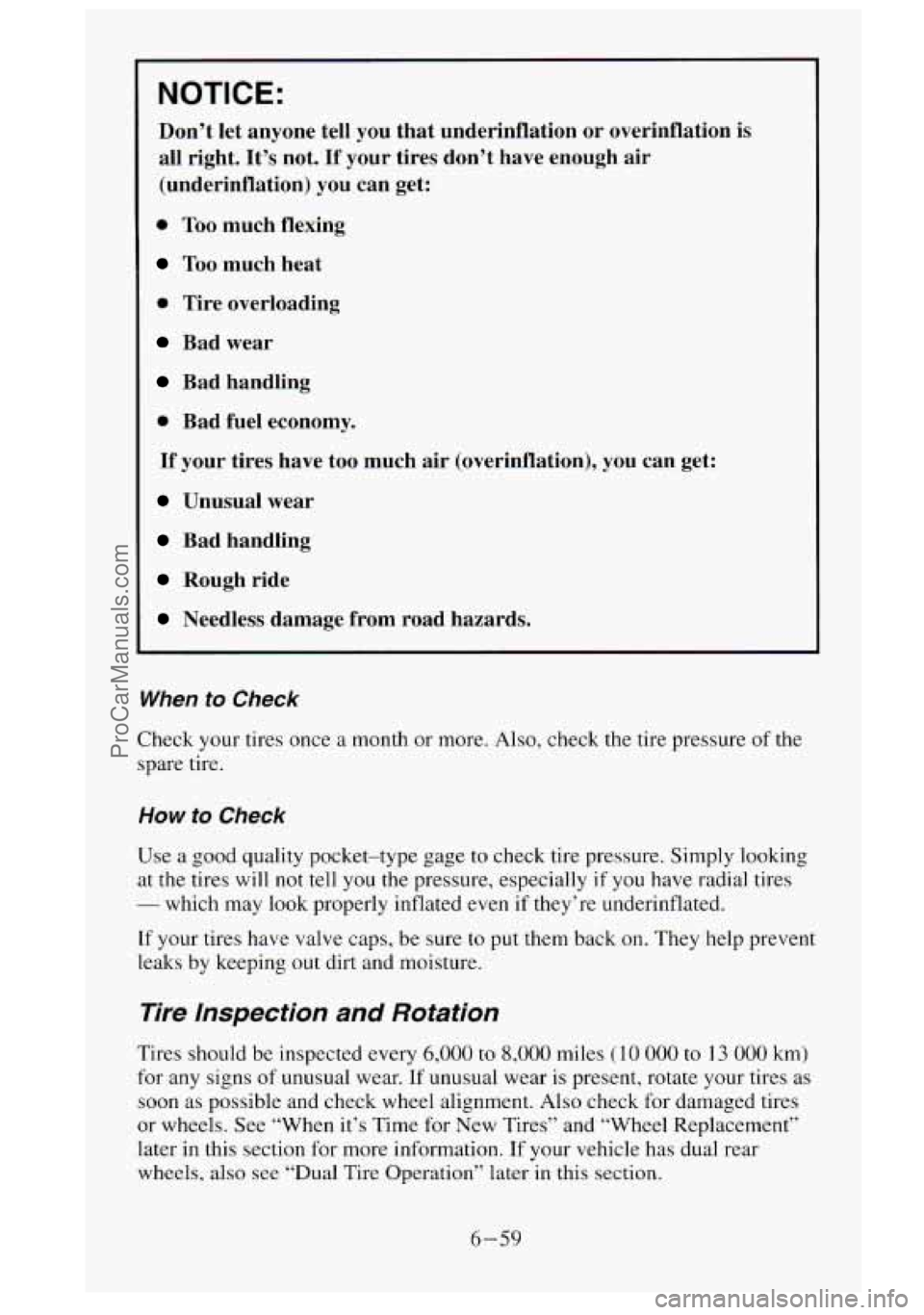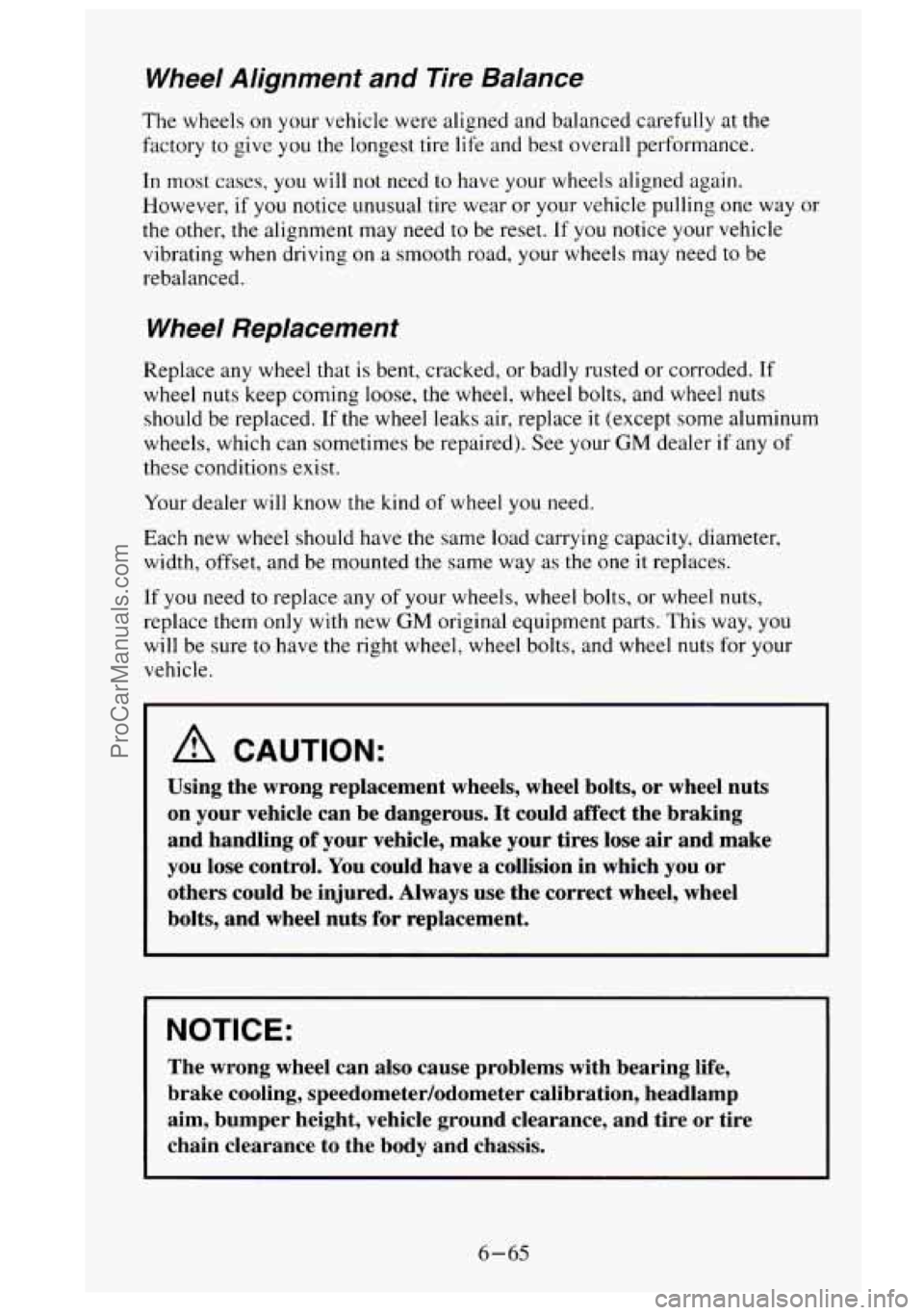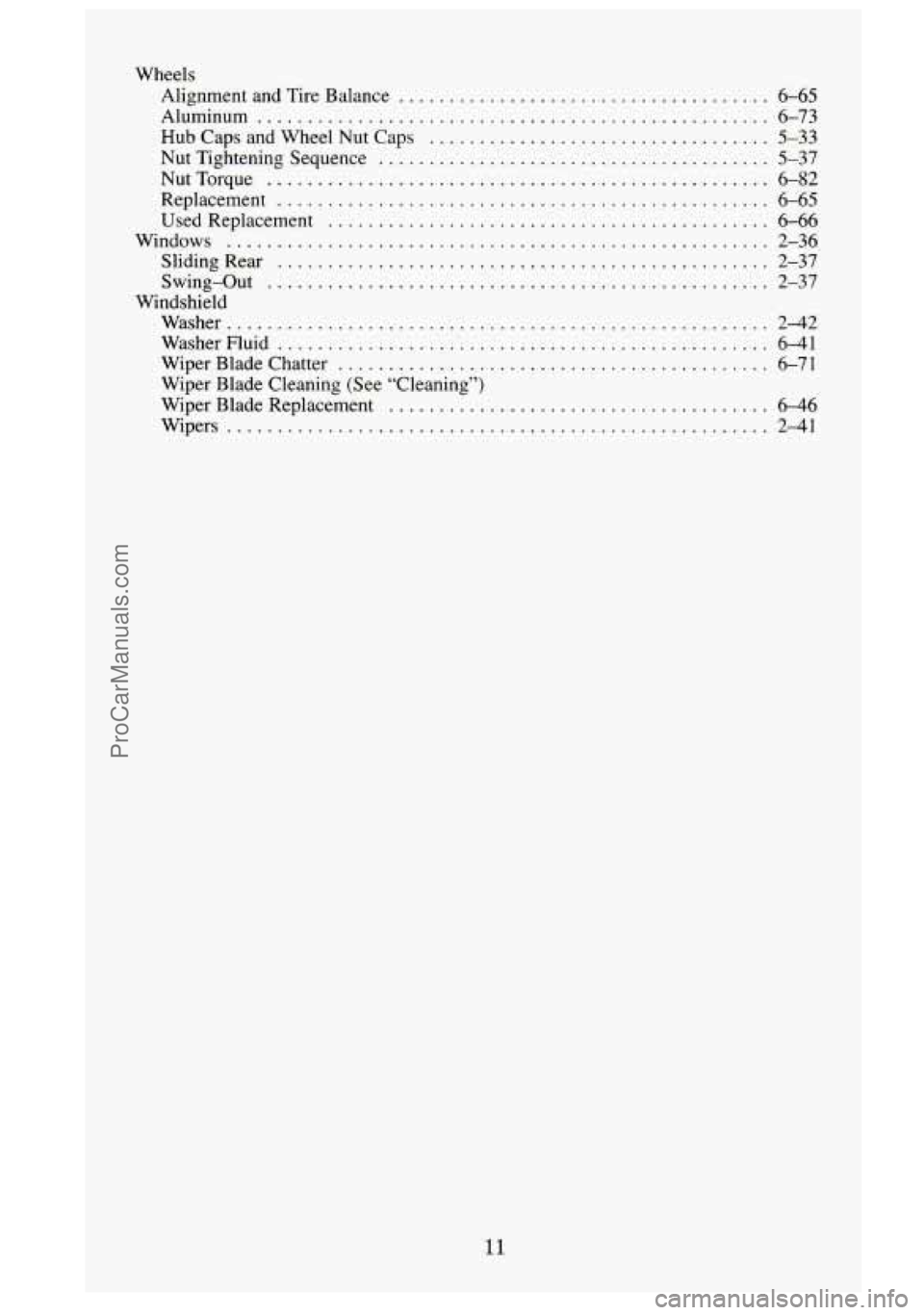1995 GMC SIERRA wheel alignment
[x] Cancel search: wheel alignmentPage 325 of 488

NOTICE:
Don’t let anyone tell you that underinflation or overinflation is
all right. It’s not.
If’ your tires don’t have enough air
(underinflation)
you can get:
0 Too much flexing
Too much heat
0 Tire overloading
Bad wear
Bad handling
0 Bad fuel economy.
If your tires have too much air (overinflation), you can get:
Unusual wear
Bad handling
Rough ride
Needless damage from road hazards.
When to Check
Check your tires once a month or more. Also, check the tire pressure of the
spare tire.
How to Check
Use a good quality pocket-type gage to check tire pressure. Simply looking
at the tires will not tell you the pressure, especially
if you have radial tires
- which may look properly inflated even if they’re underinflated.
If your tires have valve caps, be sure to put them back on. They help prevent
leaks by keeping out dirt and moisture.
Tire Inspection and Rotation
Tires should be inspected every 6,000 to 8,000 miles (10 000 to 13 000 km)
for any signs of unusual wear. If unusual wear is present, rotate your tires as
soon as possible and check wheel alignment. Also check for damaged tires
or wheels. See “When it’s Time for New Tires” and “Wheel Replacement”
later in this section for more information.
If your vehicle has dual rear
wheels, also see
“Dual Tire Operation” later in this section.
6-59
ProCarManuals.com
Page 331 of 488

Wheel Alignment and Tire Balance
The wheels on your vehicle were aligned and balanced carefully at the
factory
to give you the longest tire life and best overall performance.
In most cases, you will not need to have your wheels aligned again.
However, if
you notice unusual tire wear or your vehicle pulling one way or
the other,
the alignment may need to be reset. If you notice your vehicle
vibrating when driving
on a smooth road, your wheels may need to be
rebalanced.
Wheel Replacement
Replace any wheel that is bent, cracked, or badly rusted or corroded. If
wheel nuts keep coming loose, the wheel, wheel bolts, and wheel nuts
should be replaced.
If the wheel leaks air, replace it (except some aluminum
wheels, which can sometimes be repaired). See your
GM dealer if any of
these conditions exist.
Your dealer will know the kind of wheel you need.
Each new wheel should have the same load carrying capacity, diameter,
width, offset, and be mounted the same way as the one
it replaces.
If you need to replace any of your wheels, wheel bolts, or wheel nuts,
replace them only with new
GM original equipment parts. This way, you
will be sure to have the right wheel, wheel bolts, and wheel nuts for your
vehicle.
A CAUTION:
Using the wrong replacement wheels, wheel bolts, or wheel nuts
on your vehicle can be dangerous. It could affect the braking
and handling
of your vehicle, make your tires lose air and make
you lose control, You could have a collision in which
you or
others could be injured. Always use the correct wheel, wheel
bolts, and wheel
nuts for replacement.
NOTICE:
The wrong wheel can also cause problems with bearing life,
brake cooling, speedometer/odometer calibration, headlamp
aim, bumper height, vehicle ground clearance, and tire or tire
chain clearance to the body and chassis.
6-65
ProCarManuals.com
Page 481 of 488

Seats (continued) Reclining Front Seatbacks
....................................... 1-3
Seatback Latches
........................................... 14. 1-8
Doing Your Own Service Work ................................... 6-1
Parts Identification Label
.....................
Service
Publications
.................................
Replacement Parts and Filter Recommendations ....
Service Engine Soon Light (See “Lights”)
Servicing Your Air Bag-Equipped Vehicle (See “Supple
System (SIR)”)
Shift Indicator Light (See *‘Lights“)
Shifting Into Park (P)
...........................
Shifting Out of Park .............................
Shock Absorbers (Front) .........................
.................. 6-78
.................. 8-8
....... 6-80.6-84,6-85
:r nental Inflatable Restraint
................. 2-28
................. 2-29
................. 6-45
Specifications Chart (See “Service . Replacement Parts and Filter
Recommendations“) SpareTire
................................................. 5-28.5-29
Speedometer and Odometer (See “Gages”)
Starting Your Engine (See ”Engine-Starting”)
Steering
........................................................ 4-7
Column Shift Lever
............................................ 2-29
InEmergencies
................................................ 4-8
Tips
......................................................... 4-7
Step-Bumperpad ................................................ 2-84
Storage Compartments
............................................ 2-59
Sunvisors
..................................................... 2-57
Supplemental Inflatable Restraint System (SIR)
........................ 1-19
Adding Equipment to Your Facial Air Bag-Equipped Vehicle
.......... 1-23
How the Air Bag System Works .................................. 1-20
Servicing Your Air Bag-Equipped Vehicle
......................... 1-23
Surge Tank Pressure Cap
.......................................... 6-39
T
Tachometer (See “Gages”)
Tail~ate
......................................................... 2-4
Removal ..................................................... 2-4
TIleft ........................................................... 2-8
Thermostat
..................................................... 6-40
Tilt Wheel (Option) .............................................. 2-38
Tires
.......................................................... 6-58
Balancing (See “Wheel Alignment and Tire Balance”)
Chains
...................................................... 6-66
Dual Tire Operation ........................................... 6-62
Flat (See ”Changing
a Flat Tire”)
Inspection and Rotation
........................................ 6-59
Loading (See “Loading Your Vehicle”)
New
........................................................ 6-63
Pressure
..................................................... 6-58
Spare (See ”Spare Tire”)
Uniform Tire Quality Grading
................................... 6-63
Top Strap (See “Safety Belts-Child Restraints“)
Torque Lock (See “Transmission-Torque Lock“)
9
ProCarManuals.com
Page 483 of 488

Wheels Alignment and Tire Balance
..................................... 6-65
Aluminum
................................................... 6-73
Hub Caps and Wheel Nut Caps .................................. 5-33
Nut Tightening Sequence
....................................... 5-37
NutTorque
.................................................. 6-82
Replacement ................................................. 6-65
Used Replacement
............................................ 6-66
Windows ...................................................... 2-36
SlidingRear
................................................. 2-37
Swing-Out
.................................................. 2-37
Washer ...................................................... 2-42
WasherFluid
................................................. 6-41
Wiper Blade Chatter ........................................... 6-71
Wiper Blade Cleaning (See “Cleaning”)
Wiper Blade Replacement
...................................... 6-46
Wipers
...................................................... 2-41
Windshield
11
ProCarManuals.com